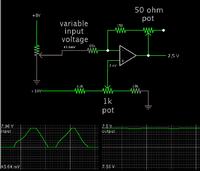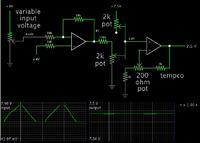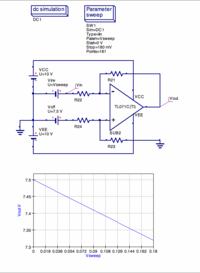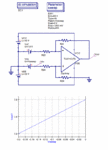Now_and_Zen
Newbie level 5
Hi Everyone,
My first post, so do be gentle with me ;-)
Here's my schematic:
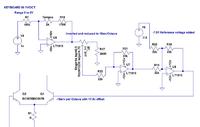
I am designing a vintage style analog monosynth which needs 1 volt per octave input from a Midi to CV convertor.
The base of one side of the pnp expo convertor requires -18mv per octave, which needs to be offset by +7.5 volts, so 0 volts input would give +7.5v, 1v in would give +7.482v, 2V in would give +7.464v etc to the base of Q1
The voltages need to be very precise for accurate tuning, hence the use of precision op amps.
I have got the desired result from the circuit shown, but it is messy and I'm sure it can be simplified; I've tried adding bias directly to the op amps but can't seem to make it work.
I was going to use a TL431 and associated resistors to generate the 7.5v reference voltage. I have + and - 10v rails and it can be taken from positive or negative rail. I've shown it taken from from negative rail and inverted.
I'm happy with the circuit up to the trim pot, its the ref voltage and two inverting op amps implementation that seems messy.
I'm a hobbyist, nothing pro here as you can probably tell!
Be really grateful if anyone could help.
Thanks,
Allan
My first post, so do be gentle with me ;-)
Here's my schematic:

I am designing a vintage style analog monosynth which needs 1 volt per octave input from a Midi to CV convertor.
The base of one side of the pnp expo convertor requires -18mv per octave, which needs to be offset by +7.5 volts, so 0 volts input would give +7.5v, 1v in would give +7.482v, 2V in would give +7.464v etc to the base of Q1
The voltages need to be very precise for accurate tuning, hence the use of precision op amps.
I have got the desired result from the circuit shown, but it is messy and I'm sure it can be simplified; I've tried adding bias directly to the op amps but can't seem to make it work.
I was going to use a TL431 and associated resistors to generate the 7.5v reference voltage. I have + and - 10v rails and it can be taken from positive or negative rail. I've shown it taken from from negative rail and inverted.
I'm happy with the circuit up to the trim pot, its the ref voltage and two inverting op amps implementation that seems messy.
I'm a hobbyist, nothing pro here as you can probably tell!
Be really grateful if anyone could help.
Thanks,
Allan
